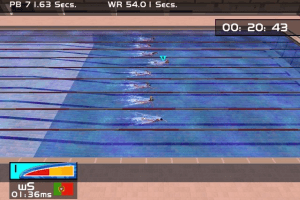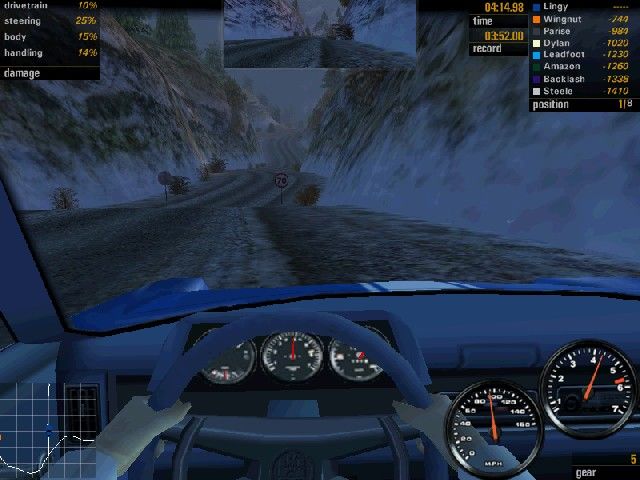Sydney 2000
Windows - 2000
Description of Sydney 2000
Olympic Fever
It seems that every four years, people around the globe become singularly possessed by a condition known as "Olympic fever." As the games of the XXVIIth Olympiad got underway in Sydney, Australia during the past week, occurrences of this condition have continued to escalate. You need only to look around you to find examples of the Olympics' influence on everyday life. A quick survey of common household products will likely result in encountering everything from the "official credit card of the 2000 Olympics" to the "official snack food of the 2000 Olympics" and, yes... even the "official video game of the 2000 Olympics!"
Sydney 2000, developed by Attention To Detail (ATD) and published by Eidos Interactive, is the aforementioned official video game of the 2000 Summer Games. Unlike products such as the "official nose hair tweezers of the 2000 Olympics" (I truly hope such a product doesn't exist or else there's a nose hair tweezer company filing a libel suit against me as we speak), the game doesn't attempt to merely cash in on the Olympic feeding frenzy. A lot of thought and effort went into attempting to produce a viable and entertaining game based on the Olympic events. Sydney 2000 possesses many laudable qualities, which I'll outline in the following paragraphs. Unfortunately, it also suffers from a number of flaws that severely hamper its success.
First, the Good News...
Before I get into what I didn't like about Sydney 2000, I'd like to spend a few moments discussing some of the characteristics that I did enjoy. The game includes 12 Olympic events: 100-meter sprint, 110-meter hurdles, javelin, hammer, triple jump, high jump, skeet shooting, 100-meter freestyle swimming, 10-meter platform diving, super heavyweight weight lifting, sprint cycling, and kayak slalom. Although ATD and Eidos have done a fairly good job selecting a representative sampling of Olympic events, I have to question the conspicuous absence of any gymnastics events. Parallel and/or uneven bars would have been a welcome addition. Inclusion of either of these events would have gone a long way in rounding out the line-up.
Sydney 2000 allows you to adjust your "handicap" on a scale of 1-5, giving you more flexibility than the easy/medium/hard difficulty settings typical of most games. You can choose which country you wish to represent from a list of 32. You can opt to play in one of four modes---arcade, Olympic, head to head (multiplayer), or coaching mode. Although I didn't receive much coaching when running the 100-meter sprint in coaching mode, I did encounter the unique feature of each heat pitting me against an instant replay "ghost" image of my best time. I found this very helpful in working towards consistently matching or beating that time.
Probably the best feature of Sydney 2000 is its authenticity. ATD has done an excellent job of recreating the actual Olympic venues in Sydney, based on true architectural design blueprints. This provides you with the look and feel of really being there. Each of the events is presented in a television broadcast style utilizing over six hundred camera positions based on the actual International Olympic Committee's global feed. Another nice touch of is the inclusion of voice-overs provided by the actual Olympic commentators. In addition to the locales, graphics are generally pretty good throughout. Player movements are realistic, whether performing warm-up stretches, running, jumping, swimming, or whooping it up after a victory (although it gets tiresome seeing athletes react with the same celebratory behaviors after each heat).
I was also impressed with the attention to detail (no pun intended), including a visual feast of textures such as properly shifting\stretching shadows, muscular definition, and facial expressions. There are even air bubbles escaping from the swimmers' nostrils in the 100-meter freestyle swimming event. Other nice touches include hurdles that rock without falling if you barely bump them, and a high jump bar that wobbles without falling if you just graze it. My only complaint with the graphics is that the athletes appear somewhat "blocky" unless you play on the highest detail setting, which may adversely affect performance on some older systems.
There's no doubt about it. Sydney 2000 is a great looking game that is true to its premise and accurately representative of its namesake. The problem, as I'm about to point out in some detail, is that the gameplay (or lack thereof) and frenetic controller techniques required to facilitate the athletes' movements don't even come close to what's expected from today's discriminating gamer.
And Now the Bad...
Sydney 2000's biggest flaw is its repetitive and tedious control system. For almost every event, gameplay consists of alternately pressing two keys as rapidly as possible to build up power and occasionally mashing the "action" button. The 100-meter sprint consists almost exclusively of this constant key hammering. You are instructed to press the "action" button as you approach to lean into the finish line. This action is not necessary to win, however, except maybe at higher difficulty settings when the other competitors are right on your heels. Then it could make a big difference in the outcome, but it still doesn't take all that much skill. The 110-meter hurdle event is a slight improvement over this. At least timing the action button to jump the hurdles provides a bit of challenge.
For the javelin, you still have to build up power, but I found that it didn't require as frantic a pace as the track events. As you prepare to throw the javelin, you press and hold the action button, and then attempt to release it when the trajectory gauge reads 45 degrees. The hammer throw is essentially identical, except that you have to time the release of the action button so that you're lined up with the opening at the front of the cage. This twist does add a reasonable amount of challenge to the button-pressing marathon. The high jump is comprised of building up power on your approach and then pressing the action button to jump over the bar, while the triple jump requires you to press the action key---you guessed it!---three times. A nice feature of the high jump is that, after each successful attempt, the bar is raised for the next jump.
The 100-meter freestyle swim operates on the same principle as the 100-meter sprint. Press the keys as fast as you can to swim up and back the length of the pool. Oh yeah, you do use the action key to turn around. Platform diving is somewhat of a breath of fresh air. You select which dive you're going to perform and then have to press a series of keys to execute each stage of the dive. The only problem is that you must time your keystrokes with the appearance of various colored icons and must memorize which key is associated with each color.
Probably the most frustrating event included in Sydney 2000 is skeet shooting. Although it's a refreshing change of pace not having to utilize the "power build up" technique (it's one of only three events to give you a break from this), trying to accurately aim is nearly impossible, even on the easiest difficulty setting. The kayak slalom and sprint cycling are also a bit more engaging than some of the other events. For the cycling, there's actually a little more strategy involved. You have to pace your team during the first two laps or, no matter how fast you tap the keys on the final lap, your cyclist will not have the stamina to maintain the necessary speed through the finish. Another nice feature of cycling is its split screen presentation. In contrast, the weight lifting portion of Sydney 2000 consists of building up power (guess how!) and then pressing the action key to lift the barbell. Not much excitement there.
The various gameplay modes offer some options, but there are still some concerns. Arcade play allows you to just choose an event and jump right into the action. The problem is that when you've completed that event once, it's no longer available to you. If you want to play the same event again, you'll have to back up to the main menu and choose arcade mode again. The designers should have allowed the player to choose any event as many times as desired without having to go through four or five cumbersome steps. Head to Head mode provides some multiplayer support, but only through the use of multiple controllers (or you can configure your keyboard so that up to eight players can crowd around it to play...yeah, right!). In the Olympic setting, you take your athlete through a series of tasks along the road to competing at the games in Sydney. You must train and qualify for each event at various levels (open qualification, invitational, semi-finals, etc.) before you make the team and get to compete for the gold medal. While the concept of training to increase your athlete's abilities is excellent, something gets lost in the translation here. Specifically, the treadmill and bench press exercises that comprise the gym training sessions seem entirely perfunctory and are about as much fun as watching paint dry.
Out of the Medals
Although I initially enjoyed Sydney 2000, its novelty quickly wore off and spiraled into mind-numbing tedium. The outdated control style is uninspiring at the outset and soon runs the gamut from moderately annoying to utterly infuriating. It's practically impossible, even on the easiest handicap setting, to be victorious without pounding the keys unmercifully. I'm sure this constant, frantically performed "drum roll" caused a fair amount of wear and tear on my keyboard, not to mention that it's an ergonomic nightmare. You can't configure the buttons you have to press, and after just 30-45 minutes of pounding on the left and right arrow keys way down at the bottom of my keyboard, I began to notice the onset of carpal tunnel syndrome symptoms. You can choose to use a gamepad, but this results in the game becoming almost impossible to play. As hard as it is to believe, using gamepad buttons can be even harder on your wrists and fingers.
Eidos Interactive may have aspirations of going for the proverbial gold with the release of this title, but due to its poor gameplay and literally painful demands on the player, Sydney 2000 falls far short of the mark. Its visual appeal and limited novelty are not even enough to claim the bronze.
Review By GamesDomain
External links
Captures and Snapshots
Comments and reviews
There is no comment nor review for this game at the moment.
Write a comment
Share your gamer memories, help others to run the game or comment anything you'd like. If you have trouble to run Sydney 2000 (Windows), read the abandonware guide first!
Download Sydney 2000
We may have multiple downloads for few games when different versions are available. Also, we try to upload manuals and extra documentation when possible. If you have additional files to contribute or have the game in another language, please contact us!
Windows Version
Similar games
Fellow retro gamers also downloaded these games:





































 361 MB
361 MB





